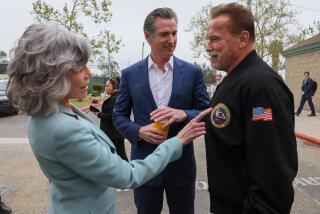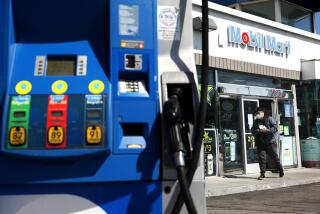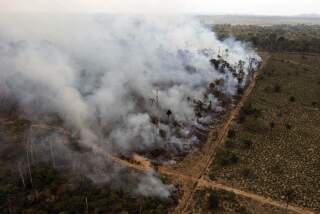‘Fracking’ the Monterey Shale -- boon or boondoggle?
“Eureka!” reads the California motto, originated in the 19th century Gold Rush. Now some believe the state is on the cusp of a 21st century bonanza, only this time it will be oil that fuels a Golden State boom.
Modern prospectors are eyeing the Monterey Shale formation, a 1,750-square-mile resource-rich swath of land in the San Joaquin Valley. Lying deep beneath the valley’s surface is a trove of shale oil — some 15.42 billion barrels’ worth, according to an estimate by the U.S. Energy Information Administration.
If that proves true, the Monterey formation holds the equivalent of 64% of America’s total shale oil reserves. A recent study by USC predicts that a Monterey Shale boom could add $4.5 billion in tax revenue to state coffers and 2.8 million California jobs by 2020, and would turn the state into the nation’s leading oil producer.
YEAR IN REVIEW: The good, the bad and the hopeful in wilderness news
But there’s a catch, or three, to that rosy scenario. First, it’s not clear that there really is that much oil in the Monterey Shale, or that it is accessible. Second, drillers are using the extremely controversial method of hydraulic fracturing, or “fracking,” to recover the oil. Third, California is committed to reducing greenhouse gas emissions 25% by 2020, and many question the wisdom of drilling on state land for fossil fuels that will only worsen the problem.
The combination of potential oil riches and a robust environmental movement has led to a collision of tectonic proportions in the state. Indeed, the fight over the Monterey Shale raises essential questions for the future of California and the nation: How do we balance the growing demand for energy and jobs against the protection of air, land and water? How do we limit global warming while securing energy independence?
The Monterey formation is geologically complex, a brittle shale rock that has been broken and scrambled for millenniums. Oil in the shale, formed by the remains of ancient plants and animals, is buried 6,000 to 15,000 feet below ground. Since the Shamrock Gusher of 1896, the San Joaquin Valley has been the most prolific oil region in California; it is now the fourth-largest oil producer in the nation, much of it from conventional drilling, some of it from fracking. But after decades of pumping, it is unclear just how much more oil can be obtained in the valley.
In early December, a study by Canadian geoscientist J. David Hughes questioned assumptions made in the 2011 energy agency study and this year’s USC report. The Hughes report, “Drilling California: A Reality Check on the Monterey Shale,” analyzed current production data and concluded that the estimates were likely “overstated … wishful thinking” and that only a small percentage of the shale oil believed to be trapped in the formation will ever be produced.
Fracking — a term that encompasses vertical and horizontal drilling and hydraulic fracturing, a technique in which water, sand and chemicals are injected underground at high pressure to crack open shale and release hydrocarbons — is nothing if not controversial. Opponents believe that fracking chemicals pollute the water and land, and can poison humans, animals and crops. Methane, the main component of natural gas, has a global warming potential 72 times greater than CO2 over a 20-year period.
Thanks to a regulatory loophole, frackers are not required to identify the chemicals they use — some of which, like benzene, are toxic. Fracking can dredge up naturally occurring radionuclides, like radon. The injection of fracking wastewater into fault zones has also set off minor tremors from Arkansas to Britain; in 2011, Oklahoma suffered a magnitude-5.7 quake that destroyed 14 homes.
In the San Joaquin Valley, “oil and ag” have coexisted for years, but farmers are increasingly uneasy. The valley produces some $17 billion of food and crops annually. Water is a precious commodity there. Hydrofracking uses some 5 million gallons per well a year, on average, and produces contaminated wastewater. As drillers push into prime agricultural land, farmers are seeking tight restrictions and have occasionally sued energy companies.
In the U.S., there are no federal regulations governing fracking, which leaves oversight up to the states. The result is a hodgepodge. Pennsylvania has strict regulations, newcomers like Ohio have just a few laws, and Kansas has none. New York has imposed a temporary moratorium, while Vermont and New Jersey have joined France and Bulgaria in banning it outright.
California has had hardly any fracking regulations in place. State lawmakers were apparently caught flat-footed by the rapid proliferation of the technology, which has been used in over 1,000 wells, mostly in Kern County near Bakersfield. In August, a plan to frack beneath parkland in Whittier, which promised to provide $100 million in annual royalties for the city, set off a polarizing battle. State legislators were shocked to discover that numerous wells had been fracked offshore, in the federal waters of the Santa Barbara Channel (site of the 1969 oil spill that spawned California’s environmental movement), and some lawmakers and scientists are scrambling to stanch the flow of wastewater into the sea.
Gov. Jerry Brown has said that fracking presents “a fabulous economic opportunity,” though he wants to learn more about its environmental impact. In November, he released proposed fracking regulations for oil and gas wells based on SB 4, a bill sponsored by state Sen. Fran Pavley (D-Agoura Hills) and signed into law by Brown.
Both sides of the issue have attacked the law, which requires frackers to identify the chemicals they use, the state Department of Conservation to monitor air and water quality around drill sites, and for the state Department of Resources to conduct an independent, peer-reviewed assessment of fracking — but also allows hydrofracking to continue under temporary emergency regulations. The law’s backers say that some oversight, however imperfect, is better than none. Still, the full regulations won’t go into effect until 2015.
In the meantime, the contention continues. What began with rudimentary wells in Kansas in the 1940s has evolved into a sophisticated technology that is being exported to China, Argentina and South Africa, even as its impact is hotly debated here.
Against this backdrop, what happens next in California has broad import. Will the Monterey Shale be a boon, a boondoggle or, worse, an environmental mess? The large-scale risks and rewards at play in California, combined with its proceed-and-study policy, will provide the best test yet of the possibilities.
Alex Prud’homme is the author of “Hydrofracking: What Everyone Needs to Know,” and five other books, including “The Ripple Effect: The Fate of Freshwater in the Twenty-First Century,” and was the co-writer of Julia Child’s memoir, “My Life in France.”
More to Read
A cure for the common opinion
Get thought-provoking perspectives with our weekly newsletter.
You may occasionally receive promotional content from the Los Angeles Times.






